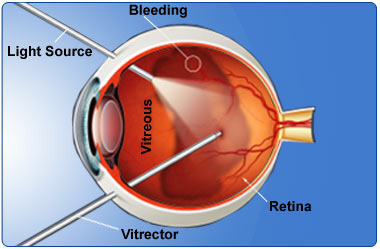What is vitrectomy?
Vitrectomy is a type of eye surgery to treat various ocular disorders that occur in the retina and vitreous. It involves the removal of the vitreous humor or fluid from the eye. The vitreous is then replaced with another solution. The vitreous is a gel-like fluid made of 98% water that fills the middle part of your eye. The retina is the innermost layer of cells in your eye. These cells are light-sensitive and use light to send visual information to the brain. In normal conditions, the vitreous is clear, so light can pass through the eye and reach the retina. However, certain conditions can cause debris and blood to block this light, which can result in vision impairment.
How do I prepare for a vitrectomy?
Many people opt to have the Surgery abroad due to the advantages of low costs with top quality treatments and they arrange this via a Medical Tourism Facilitator. To prepare for the surgery, you should discuss with your doctor what you can and cannot do. In general, you need to stop smoking and avoid certain medicines for a few days. You also need to avoid food and water (fasting) for at least 8 hours if your surgeon decides that you will need general anesthesia.
What happens during a vitrectomy?
During the surgery, the surgeon gives you local anesthesia in the form of an eye drop to numb your eye so you don’t feel anything. Since you may be awake, you can ask for a sedative to help you relax. However, there are also cases where your surgeon will give you general anesthesia. After you’re anesthetized, your eye is cleaned with an antiseptic solution and covered with a sterile layer. Your eye is kept open by an eyelid speculum and the other eye not being operated on is draped with a protective covering. Your surgeon will then make an incision in the outer layer of your eye, normally about 0.5 millimeters. After this, your surgeon makes a small cut in the sclera, which is the white part of your eye, to access the eye.

To be able to see the eye, a microscope and fiber-optic light are used. Then, the vitreous is cut and any broken-down fluid is removed. Depending on your individual case, your surgeon will perform the following:
- Peel back scar tissue from the retina using forceps, cutters, or scissors
- Drain infected, cloudy, or bloody fluid by inserting a silicone-tipped needle
- Treat abnormal blood vessels or clots and seal off retinal injuries (holes or tears) using a laser probe.
When your surgeon is finished, your eye is filled with a vitreous substitute, which is similar to saline solution, silicone oil, or air bubble or gas. The final step is to apply an antibiotic ointment to your eye to prevent infection and covering your eye with a patch.
What should I expect after the procedure?
In most cases, you can leave the hospital on the same day of the surgery. Therefore, you need to have someone to drive you after the surgery. Your surgeon will likely give you post-operative eye care instructions that you will need to strictly follow. Anti-inflammatory eye drops may be prescribed to help prevent infection. Your eyes may feel sore after the surgery, but you can take over-the-counter pain relievers and you will need to wear an eye patch for a day or two.
If you had an air bubble or gas placed on your eye, you may need to hold your head in a certain position. This will help the gas and bubble in your air to stay in the correct place. Until the gas dissolve, your vision will not be great. If you undergo the surgery in a foreign country, you should stay in that country until the gas or bubble has dissolved fully because you will be prohibited to fly above 2,000 feet.
Your surgeon will schedule a follow-up check-up to see whether the procedure was effective to your eye. On your follow-up check-up, make sure to tell your doctor if you experience decreasing vision or increasing swelling and pain around your eye.
The recovery time varies from one person to another. Generally, your eye will fully recover in 4 to 6 weeks.
Why would you get a vitrectomy?
A vitrectomy is a treatment option for some ocular disorders, mostly disorders that cause fluid in the vitreous to cloud, harden, filled with debris or blood, or scarred, and prevent light to pass through your eye and reach your retina. These disorders include:
- A hole in the center of your retina (macula)
- A wrinkle in the center of your retina
- Bleeding inside of the eye
- Certain complications after a cataract surgery
- Diabetic retinopathy
- Infection inside of the eye
- Retinal detachment
- Severe eye injury
- Vitreous hemorrhage
All of the disorders above can lead to vision loss. Some of them can also result in blindness if left untreated. It may be done in an emergency if you had an eye injury or scheduled in advance by your surgeon.
What is the success rate of a vitrectomy?
Vitrectomy is considered very successful and effective. It is also known that severe complications are very rare. According to the American Society of Retina Specialist, vitrectomy has a 90% success rate.

What are the side effects and risks of a vitrectomy?
Although very rare, there are possible side effects and complications can occur, particularly in people with immune-compromised conditions and those who have a history of eye surgery. If you think you may have a complication you need to call your surgeon right away. The risks include:
- Infection
- Inflammation, redness, pain, or swelling
- Bleeding inside of the eye
- Increased pressure (glaucoma) or decreased pressure in the eye
- Change in vision
- Blurriness, loss of night vision, or depth perception
- Retinal detachment
- Double vision
- Loss of vision
- Discoloration or dislocation of the intraocular lens
- A wrinkle in the center of the retina or macula
- Allergic reactions to anesthesia, which may result in heart attack, pneumonia, and stroke.

